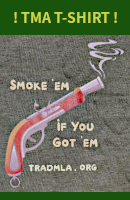As was stated , I tend to agree that the Hawkens had "insider" information that the heavy conicals were going to be the preferred solution to the need to put down the larger animals of the west ? This would be my theory to why the 1/48 and faster twist became more common on the market as time went on ? It is still my opinion that there is no need for these faster twists in guns dedicated to PRB shooting .
With all due respect to both Gordon and CaptChee, but the 1-48" twist was the most COMMONLY twist used on American made rifles LONG BEFORE the Hawken Bros. This is a fact, not conjecture or opinion, and is based on the existing database of American made PRB rifles still in existence from the 1700's to the mid 1800's, as well as the written word of the time - ask the folks at Williamsburg and other major collectors for further verification.
Despite personal "theories", the use of the 1/48" twist had nothing to do with conicals so there was no insider info and conicals generally take an even faster twist to properly stabilize. The 1-48" twist did not become more popular overtime because it was already popular all during the American made rifle roundball "era" of circa 1750-1850..........
As to whether there is a "need" for the 1-48"

Again no disrespect intended, but that's an opinion not necessarily based in fact. For myself and myself alone, I prefer to use guns built as close to the originals as possible - what others use is up to them. While a 1-48" twist was undoubtedly not the only twist used on American made rifles, but it was the most common twist used by the original shooters of PRB rifles based on the known evidence. Subsequently it is what I've used mostly now for 50 years and it has worked just fine in my rifles (most of which have been 54's because I've mostly hunted big game, including elk, and just plain prefer it.......) and several have been originals from the 1790's to the 1870's.....
The English made round ball rifles of the mid 1700's to the mid 1800's were often built with much faster twists such as 1-24" and 1-32" and they were used in both big bores and small bores (a 54 was considered small bore by the English of the day). Due to the problems with stripping due to the fast twist and often shallower grooves, they had to use smaller loads of powder (often a powder charge of 1/5 or 1/3 the ball weight was recommended and subsequently lowered velocities - Americans tended to use 1/2 the ball weight).
Some English rifles like the Baker rifles did use much slower twists, but for some reason many of the other English makers of the time continued to use faster twists. This led to "fixes" such as belted balls and other "gimmicks" to prevent stripping of the ball at higher velocities. I used to own a Purdey circa 1840 that used both belted balls and conicals and in that I could used larger loads without stripping, but that belt tended to play havoc with the balls accuracy over longer distances.
The story I heard was they had failed to pack and ship their previous rifling machine, and when they reached St. Louis, the only one to be had, was one that was 1:48. It wasn't forthought, but just dumb luck
An apocryphal story at best IMO, especially since Jake and Sam arrived in St Louis years apart.........
1) Jake arrived in St Louis in 1818 and partnered up with another smith, Lakenan, until Lakenan's death in 1825. Prior to that he worked at Harper's Ferry and as far as is known did not have his own shop until St Louis so Jake may not have had a machine to begin with.
2) Sam arrived in St Louis in 1822 from Ohio where he had had a shop and then ran his own ship in St Louis until the summer of 1825 when he and Jake joined up and started their famous concern.
3) Most old time smiths made their own rifling benches - making your own tools was part of becoming a journeyman and later a master. FWIW - there are at least two known Hawken rifling machines still in existence that I'm aware as well as machines from other shops both earlier and later, most are 1-48"....
Again no disrespect meant to anyone - what twist (along with anything else) you choose to use is your choice and no one else's and IMO should depend on various factors since there is really not necessarily a single best twist for any caliber in my experience and I've shot a LOT of various muzzleloaders. On the other hand I do feel that the 1-48" has gotten a bad rap for far too long and also there is the erroneous "impression" that is a modern concept rather than what history says it was - IMO there are far too many myth conceptions about such things and I at least try to set the record straight when possible.
Bottom line they can all be good - one of the most accurate rifles I have owned had a barrel by Bill Large who preferred the 1-56" over everything else for PRB, and in his own inimitable way sent me a 1-56" barrel that time, even though I had requested a 1-48" - but that was Bill and in this case he was "right" even though he was wrong....





